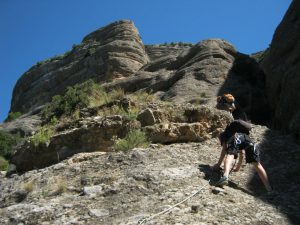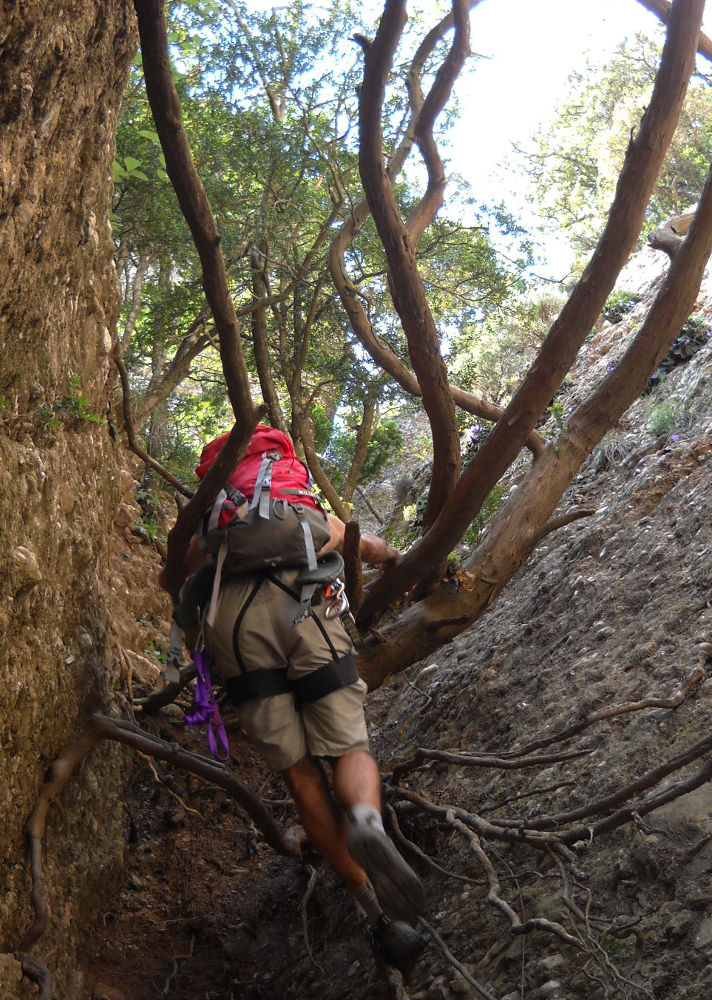TOPO
Canal del Palomo, Vadiello
Aragon, Sierra de Guara. This exceptional and historic route of the Canal d'O Ciego owes its name to the upper cirque that closes off the top of the canyon. Renamed the Canal del Palomo for the paloma hunters, the descent of the canyon was opened in the 50s by a group of climbers from the Peña Guara. They then fitted it with large nails (clavijas) and climbed it again in 1955, without insurance! Fortunately, since 1990 and particularly in 2008, the canal (or via ferrata) has been completely re-equipped with a lifeline along the entire route (including the return), and a few clavijas have been added to facilitate the ascent. Roughly speaking, it's a long vertical chimney with rounded shapes carved into the wall. It's a challenging route, with some fairly difficult pitches, vertical passages and a few overhangs. It's a great way to discover this part of the Sierra de Guara, with the Valdiello dam a little higher up, a bunch of barrancos and plenty of climbing areas to discover.

Technical summary
Location ✦ Vadiello
Region ✦ Sierra de Guara, Aragon
Country ✦ Spain
Type ✦ Via ferrata
Vertical rise ✦ 100m
Difficulty ✦ K4
Distance ✦ 275m
Duration ✦ 3h to 3h30
Access to the place
From Lerida, take the N240/A22 (autovia under construction) towards Ayerbe and Huesca. 8 kms before Huesca, after an abandoned gasolinera, turn right onto a small road towards Loporzano. Continue along the village on the HU-330 road (approx. 15 kms) until you enter Vadiello. Once you've passed the Vadiello sign, turn right at the first bend after a small bridge, and park in the designated parking area. This is also a climbing training area and the start of the via ferrata.
Itinerary description
Hiking to the start 5'
Go left, looking at the wall, on the well-marked path. Keep right without crossing the stream and after a few minutes you'll find yourself at the foot of the route with the first clavijas (nails).
Course 1h à 1h30
The via ferrata is therefore equipped only with clavijas or nails inside the rock cavities (and lifeline, of course). Although some of the nails have been damaged over time, all the equipment remained good and safe on our last visit.
After the first big boulder to cross, we soon reach the entrance to the channel that runs into the dark depths of the rock. It's impressive: the canal is virtually closed to light, and we can already see the first pozas or stagnant pools of water formed by the erosion of the water.
From this point on, it's difficult to divide the ferrata into distinct sections. There are at least 3 or 4 deep pitches leading to flat areas where belays are set up for belaying from above or abseiling down. Nails are sometimes well spaced out and you have to use supports on the walls to climb, avoiding slippery wet areas. Some of the pitches are very vertical, even slightly overhanging, with some tricky angles to work around.
It is important, as indicated on the information sign at the bottom of the route, not to step in the small pools (pozas), in order to respect the eco-system of this particular environment. The safety cable is well positioned to protect the entire climb. A thought for the "apuristas" of the 50's who climbed here without any belay...
After an hour at the bottom of the canal, in the shade and humidity (of course, avoid doing this when it's raining), we emerge suddenly into the sun at the foot of a huge, majestic, closed, horizontally crenellated wall: the circo de Ligüerri at 900m altitude. Magnificent.
Back
It's as spectacular as climbing the canal! Turn right, following the safety cables. We then make a long traverse along the side of the wall (20′), without difficulty, which allows us to enjoy the other surrounding canyons typical of the Sierra de Guara and, if we look up, to observe the colony of griffon vultures circling above us. Go right to the end of this traverse to find the equipped path back down to the parking lot, with 2 or 3 passages of de-escalation to negotiate (20′).


































Leave a Reply